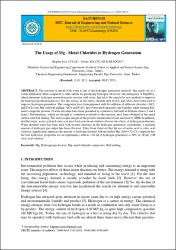| dc.contributor.author | Aytaş,Begüm Esra | |
| dc.contributor.author | Karaoğlu,Sevim Yolcular | |
| dc.date.accessioned | 2022-05-05T12:32:28Z | |
| dc.date.available | 2022-05-05T12:32:28Z | |
| dc.date.issued | 2021 | en_US |
| dc.identifier.citation | Aytaş, B. E. & Yolcular Karaoğlu, S. (2021). The Usage of Mg - Metal Chlorides in Hydrogen Generation . NATURENGS , 2 (1) , 60-73 . DOI: 10.46572/naturengs.858208 | en_US |
| dc.identifier.isbn | 2717-8013 | |
| dc.identifier.uri | https://dergipark.org.tr/tr/pub/naturengs/issue/60455/858208 | |
| dc.identifier.uri | https://hdl.handle.net/20.500.12899/1058 | |
| dc.description.abstract | The reaction of metals with water is one of the hydrogen generation methods. Mg stands out as a viable alternative when compared to other metals for producing hydrogen. However, the emergence of Mg(OH)2, which interrupts hydrogen production in its reaction with water, has led to the search for new methods to improve the hydrogen production process. For this reason, in our study, chloride salts (CoCl2 and AlCl3) have been used to improve hydrogen generation. The composites have been prepared with the addition of different chlorides (AlCl3 and CoCl2) into Mg with ball milling. AlCl3 and CoCl2 have been used separately and together while forming Mg metal composite powder. Powder mixtures have been grounded by a planetary ball mill at different times (2 and 4 hours). Deformations, which are thought to contribute positively to the reaction, have been obtained on the metal surface with ball milling. The microscopic images of the powder mixtures have been analyzed by SEM. In addition, distilled water, acetic acid and citric acid have been used in our study to observe the effects of hydrogen production. When distilled water has been used with powder mixtures in the hydrogen generation experiments, a minimal amount of hydrogen gas output has been observed. It has been observed that the use of acetic acid or citric acid solutions significantly enhances the amount of hydrogen formed. 4 hours milled Mg- 10wt% CoCl2 composite has the best hydrolysis properties for all experiments with its 138 ml of hydrogen generation at 30oC in 30 ml, 2 M citric acid solution. | en_US |
| dc.language.iso | eng | en_US |
| dc.relation.isversionof | DOI: 10.46572/naturengs.858208 | en_US |
| dc.rights | info:eu-repo/semantics/openAccess | en_US |
| dc.subject | Mg | en_US |
| dc.subject | Hydrogen Production | en_US |
| dc.subject | Mg- Metal Chloride Composites | en_US |
| dc.subject | Ball- Milling | en_US |
| dc.title | The Usage of Mg - Metal Chlorides in Hydrogen Generation | en_US |
| dc.type | article | en_US |
| dc.authorid | 0000-0003-3528-208X | en_US |
| dc.authorid | 0000-0003-0954-6889 | en_US |
| dc.department | MTÖ Üniversitesi | en_US |
| dc.identifier.volume | 2 | en_US |
| dc.identifier.issue | 1 | en_US |
| dc.identifier.startpage | 60 | en_US |
| dc.identifier.endpage | 73 | en_US |
| dc.relation.journal | NATURENGS | en_US |
| dc.relation.publicationcategory | Makale - Ulusal Hakemli Dergi - Başka Kurum Yazarı | en_US |


















